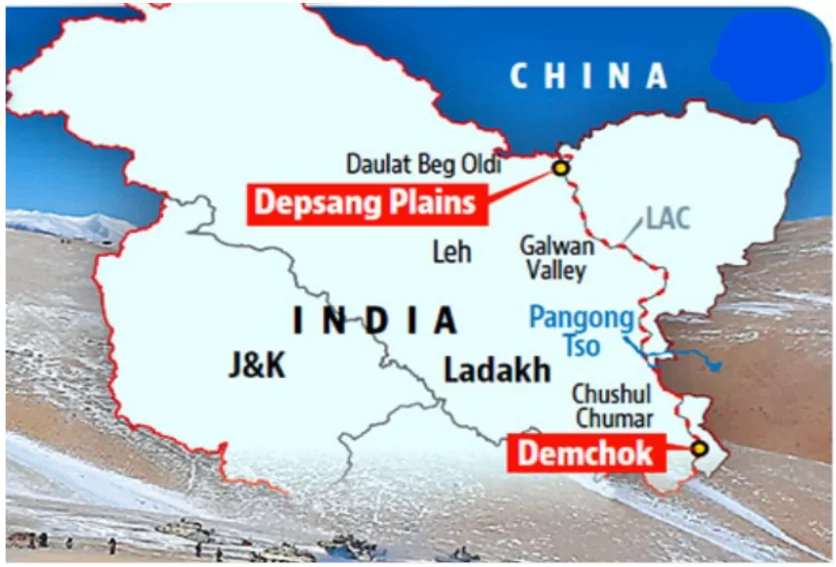Ahead of the BRICS summit, India and China announced an agreement on patrolling arrangements and resolved remaining border friction points, effectively restoring the situation to pre-2020 levels.
Background
The India-China 2020 escalation marks a significant military standoff along the Line of Actual Control (LAC) that began in May 2020, resulting in the most serious confrontation between the two nations in decades.
Click to Know BRICS Summit 2024
Key Events
- Military Confrontations: Aggressive scuffles, face-offs, and skirmishes occurred at various locations in Eastern Ladakh, including the Depsang Plains, Hot Springs, Gogra, Galwan Valley, and the banks of Pangong Tso.
- These confrontations, particularly in the Galwan Valley, resulted in the deaths of 20 Indian soldiers, highlighting the escalating conflict in the region.
- India’s Response
- Military and Diplomatic Measures: In response, India fortified its military presence and engaged diplomatically to de-escalate tensions while asserting territorial claims. This included prioritising border issues over trade with China.
- Economic Countermeasures: India imposed bans on Chinese apps and strengthened strategic partnerships to mitigate China’s influence.
- Negotiations and Disengagement
- Diplomatic Engagement: India shifted its diplomatic focus, emphasising border resolution through military, diplomatic, and political negotiations.
- For example, military commanders have conducted more than 17 meetings, including discussions in the Working Mechanism for Consultation and Coordination (WMCC).
- Disengagement Process: These efforts led to troop repositioning and disengagement from several friction points, such as the Galwan Valley, Hot Springs, Gogra, and the Pangong Tso region.
- However, discussions regarding the strategically important Depsang Plains and Demchok remained contentious, with China resisting negotiations.
- Current Status: Recently, disengagement from Demchok and the Depsang Plains has also been announced. With this disengagement now in place, the next step will be de-escalation.
Enroll now for UPSC Online Course
Strategic Importance of Depsang Plains
- Military Offensive Capability: The Depsang Plains are crucial for China due to their flat terrain, which facilitates the movement of troops, heavy vehicles, and tanks, thereby enabling large-scale military offensives against Indian positions.
|

Difference between ‘Disengagement’ and ‘De-escalation’:
- Disengagement refers to the withdrawal from a military position or policy, often involving the removal of forces from a conflict area.
- It requires bilateral action and can occur when the enemy lacks credible threats.
- De-escalation refers to the process of reducing tensions in a conflict, typically involving the withdrawal of forces back to their bases and transitioning from higher levels of aggression to lower ones.
- It encompasses diplomatic efforts, military posturing, and conflict resolution strategies aimed at preventing escalation into larger-scale confrontations, including war.
- De-escalation aims to stabilise a situation, fostering dialogue and negotiation while mitigating the risks of conflict.
Thus, while disengagement focuses on the physical withdrawal of military forces, de-escalation emphasises managing relationships and reducing hostility. |
India-China Disengagement Agreement
- The recent agreement between India and China addresses the longstanding border tensions in the region.
- Initially, the two countries had established buffer zones where neither side’s troops were stationed.
Key Points of the Proposed Agreement
- Restoration of Patrol Rights: Troops from both countries will resume patrolling areas that were previously monitored before 2020. This marks a significant shift in the approach to border management.
- Limited Patrol Frequency: Patrols will occur only twice a month, with prior notification to the other country to minimise the risk of face-offs or direct contact between forces.
- Troop Limitations: Each patrolling party will consist of a maximum of 14 soldiers, ensuring that the patrols remain non-threatening and manageable.
- Commander-Level Meetings: Regular meetings between military commanders will be held to facilitate communication and address any emerging issues promptly.
Check Out UPSC CSE Books From PW Store
Role of Big Forums in Conflict Resolution
After 4.5 years of heightened tensions, this agreement represents a hopeful step towards stabilising relations. It comes at a crucial time as the Prime Minister prepares to attend the BRICS meeting, highlighting the importance of diplomatic engagement in resolving conflicts
Examples:
- Doklam Issue (2017):The India-China standoff at Doklam was effectively addressed during the BRICS Summit.
- Dogra Hot Springs: This issue was resolved prior to the SCO meeting, demonstrating how high-level discussions can facilitate conflict resolution.
Chinese Motive
- Understanding China’s motives for conceding patrolling rights at this juncture is essential, especially considering the lack of progress in discussions since the last disengagement at Patrolling Point 15 in September 2022.
- The context of external pressures, such as tensions in the Taiwan Strait and economic uncertainty at home, may have influenced this decision.
- Additionally, Russia’s role cannot be overlooked. As a key ally to both India and China, Russia has been advocating for stability in the region and may have facilitated dialogue between the two nations.
|
Way Forward
- Transition from Disengagement to De-escalation: While disengagement has been achieved, the focus should now shift towards de-escalation of tensions between the two nations.
- Building Trust: It is essential to bridge the existing trust deficit. Open communication and transparency can foster a better relationship.
- Infrastructure Development: Improving infrastructure along the border areas can help avoid friction and misunderstandings during ongoing talks.
- Maturity in Relations: Both countries must exhibit maturity in handling conflicts, recognizing that friction is a possibility between two major states.
- Vigilance: India should maintain vigilance to protect its interests while engaging in diplomatic efforts. Continuous monitoring of the situation is crucial to prevent any resurgence of tensions.
Enroll now for UPSC Online Classes
Conclusion
The recent news indicating China’s readiness to engage in further disengagement at specific points can be seen as a diplomatic win for India. This shift reflects China’s previous reluctance to discuss these sensitive areas, showcasing India’s effective diplomatic efforts to address border tensions.
![]() 22 Oct 2024
22 Oct 2024


